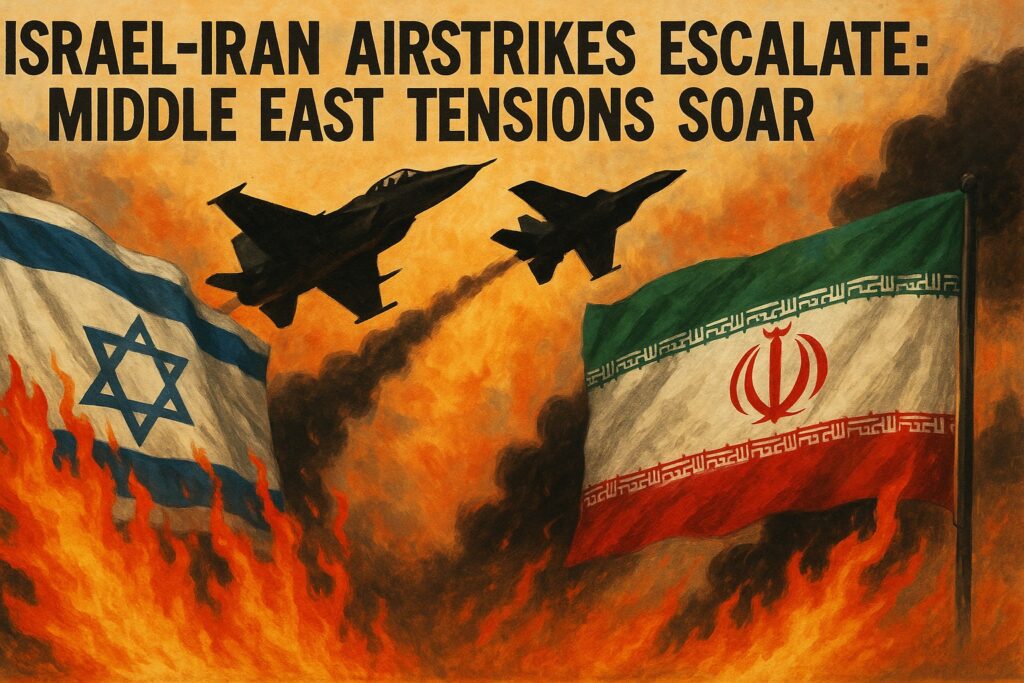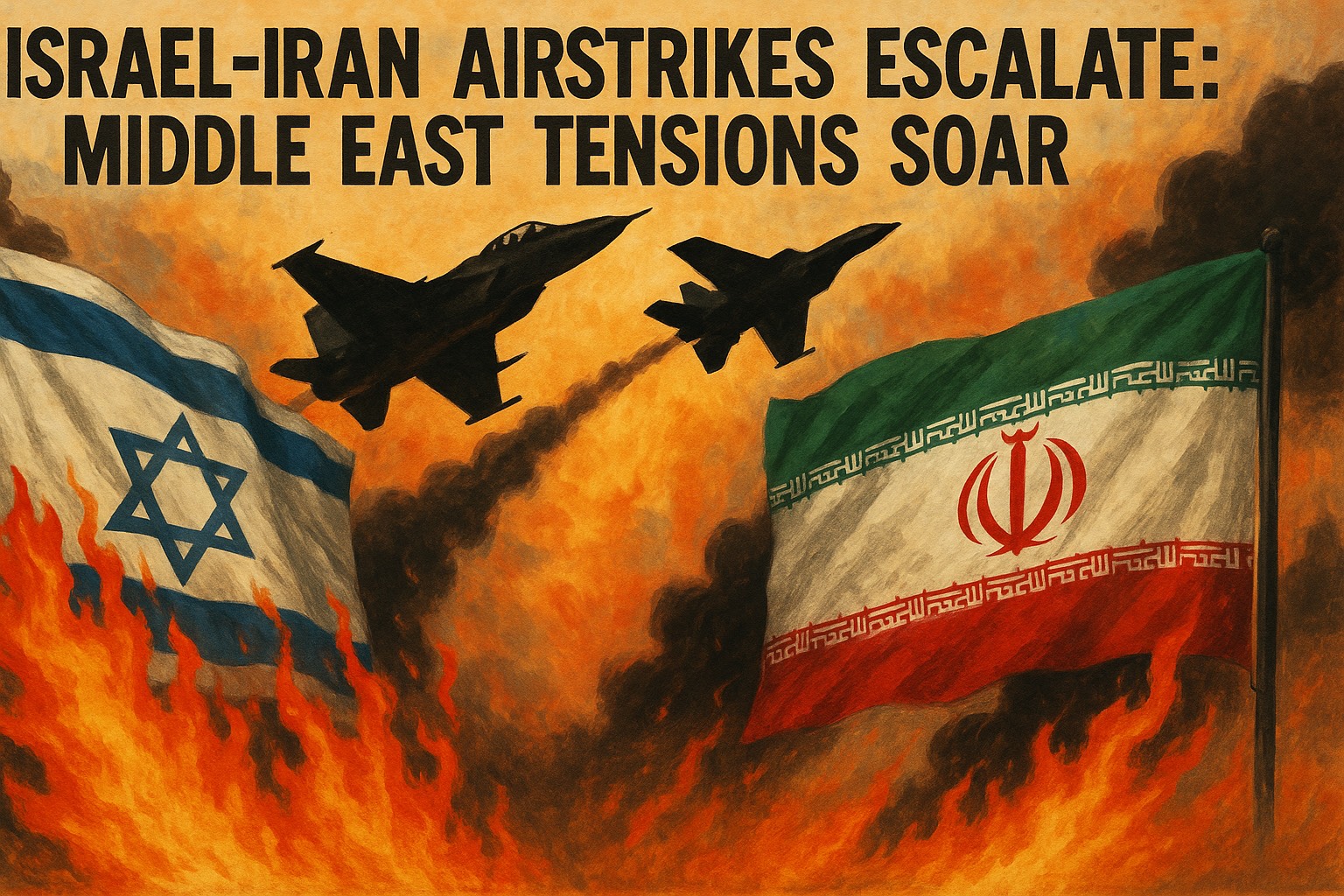Iran Airstrikes Shake Middle East: Dozens Killed in Explosive Clash With Israel

In a sharp escalation of hostilities, the Middle East witnessed a dramatic surge in violence as Iran airstrikes and Israeli retaliatory bombings plunged the region into chaos. Early Saturday, Iran launched a series of powerful missile barrages targeting Israeli cities, including Tel Aviv and Jerusalem, in response to Israel’s most extensive military offensive against Iran to date.
With both nations engaging in relentless aerial assaults, fears of a full-scale regional war have gripped the global community. As casualties rise and infrastructure lies in ruins, world leaders are calling for restraint, but the path forward remains dangerously uncertain.
🔥 Iran Airstrikes Rock Israel in ‘Operation True Promise’
The Iranian offensive, officially named “Operation True Promise,” marked a significant shift in Tehran’s military posture. Iran airstrikes struck central Israel, breaching its Iron Dome defense system and causing widespread panic. Air raid sirens blared across Tel Aviv, while residents rushed to shelters.
Key details from the Iranian attack include:
- Three Israeli citizens killed, including one woman.
- At least 34 injured, with many in critical condition.
- Long-range ballistic and cruise missiles fired at civilian and military targets.
- Direct hits near Tel Aviv and Jerusalem, causing significant damage.
Iran’s supreme leader, Ayatollah Ali Khamenei, addressed the nation just hours before the strikes, vowing to inflict “heavy blows” on what he called a “malevolent enemy.” His message was clear: the Iran airstrikes were a retaliation for Israel’s aggressive action the previous day.
🛡️ Israel’s ‘Operation Rising Lion’: A Calculated Offensive
The Iranian attack followed Israel’s launch of “Operation Rising Lion,” a massive preemptive strike initiated on Friday. According to Israeli officials, the operation was carefully planned as early as November 2024, shortly after the assassination of Hezbollah leader Hassan Nasrallah.
The Israeli military reportedly deployed drones and warplanes, some of which had been covertly smuggled into Iranian territory, to target sensitive installations.
Key highlights of Israel’s offensive:
- Direct strikes on Iran’s nuclear enrichment facilities.
- Targeted assassinations of top Iranian military commanders, including:
- General Mohammad Bagheri (armed forces chief),
- General Hossein Salami (head of Revolutionary Guard),
- General Amir Ali Hajizadeh (missile program chief).
- Bombing of critical infrastructure in Tehran, including Mehrabad Airport.
Israeli Prime Minister Benjamin Netanyahu declared the offensive as just the beginning, describing it as a necessary step to neutralize what he called the “existential threat” posed by Iran’s nuclear ambitions.
🚨 Iron Dome Breached: Israeli Cities Under Fire
The Iran airstrikes exposed vulnerabilities in Israel’s vaunted Iron Dome air defense system, which failed to intercept several incoming projectiles. Explosions echoed across Tel Aviv, Jerusalem, and central Israel, disrupting daily life and overwhelming emergency services.
Footage from the ground showed burning buildings, shrapnel-riddled cars, and terrified residents. Hospitals reported a surge in casualties, with injuries ranging from shrapnel wounds to trauma caused by collapsed buildings.
Israeli military sources confirmed that this was one of the most severe attacks on their territory in recent years.
🌍 Global Leaders React to Escalating Iran Airstrikes
As Iran airstrikes intensified and Israel continued retaliatory bombings, the international community moved swiftly to address the spiraling crisis.
- UN Secretary-General António Guterres urged immediate cessation of hostilities and called for a return to diplomacy.
- India, expressing deep concern, called on both nations to avoid further escalation. Prime Minister Narendra Modi reportedly spoke to Netanyahu and reiterated India’s commitment to regional peace.
- Former U.S. President Donald Trump confirmed American intelligence was aware of the situation in advance. He stated: “We knew everything… I tried to save Iran from humiliation and death. There’s still time to work out a deal.”
While the U.S. remains officially neutral, American air defense systems in the region were reportedly used to intercept a portion of Iran’s missile barrage.
🧨 Tehran in Ruins: Aftermath of Israeli Retaliation
In response to the Iran airstrikes, Israel launched a third wave of bombings on Tehran Saturday morning. Explosions were reported near Mehrabad Airport, home to both military and civilian aircraft and located near sensitive Iranian leadership sites.
Witnesses described fireballs lighting up the skyline, with emergency sirens wailing across the capital. Local media confirmed the destruction of several military facilities and residential areas.
Iranian casualty figures are grim:
- At least 78 killed, many of them civilians.
- Over 320 wounded, overwhelming Tehran’s hospitals.
- Power outages and communication disruptions in affected areas.
The Iranian government accused Israel of war crimes, vowing continued retaliation if the assaults did not cease.
🕵️ Why Now? The Backdrop to the Iran Airstrikes
The latest round of Iran airstrikes and Israeli bombings didn’t occur in isolation. The region has been simmering for months. The November 2024 elimination of Hezbollah’s Nasrallah, coupled with Iran’s alleged expansion of its nuclear program, laid the groundwork for today’s crisis.
Israel has long accused Iran of secretly enriching uranium for nuclear weapons. While Tehran insists its nuclear pursuits are peaceful, Israeli intelligence reports claimed the existence of hidden nuclear facilities and production labs.
By striking first, Israel hoped to:
- Cripple Iran’s nuclear capability.
- Destabilize its military command.
- Deter future proxy operations via groups like Hezbollah and Houthis.
📊 Civilian Toll and Humanitarian Fallout
Both nations are now dealing with a growing civilian crisis. In Iran, apartment complexes in Tehran were leveled, and rescue teams worked around the clock to pull survivors from rubble. Hospitals in Tehran and Isfahan reported a shortage of critical supplies.
In Israel, the fallout from the Iran airstrikes disrupted public transport, damaged residential buildings, and led to school closures. Bomb shelters are filled with civilians, and trauma services have been deployed to assist children and the elderly.
Humanitarian agencies warn that if escalation continues:
- Thousands may be displaced.
- Medical and food supplies will run short.
- Regional instability will push oil prices and refugee flows to new highs.
🔮 What’s Next? Possible Outcomes
The future of the Israel-Iran confrontation hinges on several critical developments. Analysts and diplomats are floating multiple scenarios:
- Prolonged military exchange: Continued Iran airstrikes and Israeli bombings may result in a long war of attrition.
- Proxy conflict escalation: Groups like Hezbollah, Hamas, and Yemeni rebels may join in, broadening the battlefield.
- International mediation: Nations like India, Turkey, or France may step in to negotiate a ceasefire.
- Nuclear agreement revival: Despite the conflict, some see an opportunity for renewed Iran nuclear deal talks, under international pressure.
🧭 Final Thoughts: Iran Airstrikes Signal New Era of Warfare
The scale, precision, and casualties from the recent Iran airstrikes have signaled a new and perilous phase in Middle Eastern geopolitics. For both Tehran and Tel Aviv, this is no longer just about ideology or regional dominance—this is a high-stakes game of deterrence, sovereignty, and survival.
While both sides claim to be defending their people, it’s the civilians—caught in the crossfire—who continue to pay the heaviest price.
As leaders from Washington to New Delhi and Brussels scramble to de-escalate tensions, the world watches nervously, knowing that what happens next in the skies over Tehran and Tel Aviv may reshape the future of the Middle East for generations.
